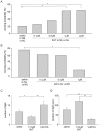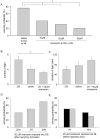Aminergic control of social status in crayfish agonistic encounters
- PMID: 24058575
- PMCID: PMC3776855
- DOI: 10.1371/journal.pone.0074489
Aminergic control of social status in crayfish agonistic encounters
Abstract
Using pairings of male crayfish Procambarus clarkii with a 3-7% difference in size, we confirmed that physically larger crayfish were more likely to win encounters (winning probability of over 80%). Despite a physical disadvantage, small winners of the first pairings were more likely to win their subsequent conflicts with larger naive animals (winning probability was about 70%). By contrast, the losers of the first pairings rarely won their subsequent conflicts with smaller naive animals (winning probability of 6%). These winner and loser effects were mimicked by injection of serotonin and octopamine. Serotonin-injected naive small crayfish were more likely to win in pairings with untreated larger naive crayfish (winning probability of over 60%), while octopamine-injected naive large animals were beaten by untreated smaller naive animals (winning probability of 20%). Furthermore, the winner effects of dominant crayfish were cancelled by the injection of mianserin, an antagonist of serotonin receptors and were reinforced by the injection of fluoxetin, serotonin reuptake inhibitor, just after the establishment of social order of the first pairings. Injection of octopamine channel blockers, phentolamine and epinastine, by contrast, cancelled the loser effects. These results strongly suggested that serotonin and octopamine were responsible for winner and loser effects, respectively.
Conflict of interest statement
Figures





Similar articles
-
Tyraminergic modulation of agonistic outcomes in crayfish.J Comp Physiol A Neuroethol Sens Neural Behav Physiol. 2018 May;204(5):465-473. doi: 10.1007/s00359-018-1255-3. Epub 2018 Feb 27. J Comp Physiol A Neuroethol Sens Neural Behav Physiol. 2018. PMID: 29488014
-
Role of cAMP signalling in winner and loser effects in crayfish agonistic encounters.Eur J Neurosci. 2016 Jul;44(2):1886-95. doi: 10.1111/ejn.13259. Epub 2016 Jun 7. Eur J Neurosci. 2016. PMID: 27086724
-
Interlocking of chelae is a key factor for dominance hierarchy formation in crayfish.J Exp Biol. 2012 Aug 15;215(Pt 16):2841-8. doi: 10.1242/jeb.072520. J Exp Biol. 2012. PMID: 22837457
-
6. Social dominance and serotonin receptor genes in crayfish.Curr Top Dev Biol. 2006;74:177-99. doi: 10.1016/S0070-2153(06)74006-6. Curr Top Dev Biol. 2006. PMID: 16860668 Review.
-
Dynamic interactions of behavior and amine neurochemistry in acquisition and maintenance of social rank in crayfish.Brain Behav Evol. 2001 May;57(5):271-82. doi: 10.1159/000047245. Brain Behav Evol. 2001. PMID: 11641563 Free PMC article. Review.
Cited by
-
Social context shapes cognitive abilities: associative memories are modulated by fight outcome and social isolation in the crab Neohelice granulata.Anim Cogn. 2021 Sep;24(5):1007-1026. doi: 10.1007/s10071-021-01492-6. Epub 2021 Mar 31. Anim Cogn. 2021. PMID: 33788037 Free PMC article.
-
Enhancement of synaptic responses in ascending interneurones following acquisition of social dominance in crayfish.J Comp Physiol A Neuroethol Sens Neural Behav Physiol. 2021 May;207(3):415-428. doi: 10.1007/s00359-021-01481-7. Epub 2021 Mar 27. J Comp Physiol A Neuroethol Sens Neural Behav Physiol. 2021. PMID: 33772639
-
Involvement of Melatonin in the Regulation of the Circadian System in Crayfish.Int J Mol Sci. 2018 Jul 23;19(7):2147. doi: 10.3390/ijms19072147. Int J Mol Sci. 2018. PMID: 30041485 Free PMC article. Review.
-
Effects of miR-143 and its target receptor 5-HT2B on agonistic behavior in the Chinese mitten crab (Eriocheir sinensis).Sci Rep. 2021 Feb 24;11(1):4492. doi: 10.1038/s41598-021-83984-6. Sci Rep. 2021. PMID: 33627750 Free PMC article.
-
Does losing reduce the tendency to engage with rivals to reach mates? An experimental test.Behav Ecol. 2024 May 3;35(4):arae037. doi: 10.1093/beheco/arae037. eCollection 2024 Jul-Aug. Behav Ecol. 2024. PMID: 38779595 Free PMC article.
References
-
- Chase I, Bartolomeo C, Dugatkin LA (1994) Aggressive interactions and inter-contest interval: how long do winners keep winning? Anim Behav 48: 393–400.
-
- Drummond H, Canales C (1998) Dominance between booby nestlings involves winner and loser effects. Anim Bahav 55: 1669–1676. - PubMed
-
- Hsu Y, Wolf LL (1999) The winner and loser effect: integrating multiple experiences. Anim Behav 57: 903–910. - PubMed
Publication types
MeSH terms
Substances
LinkOut - more resources
Full Text Sources
Other Literature Sources
Miscellaneous

